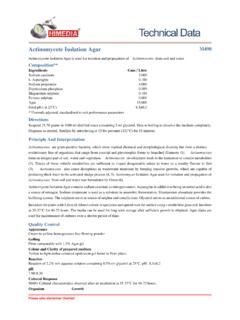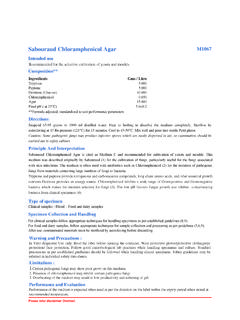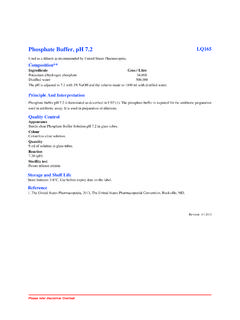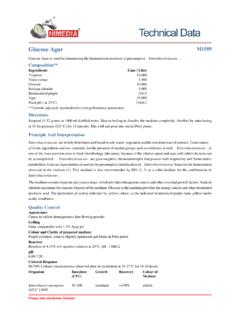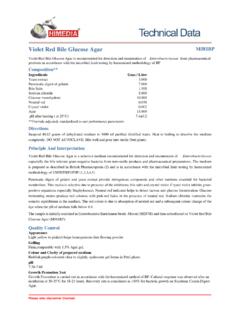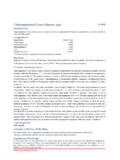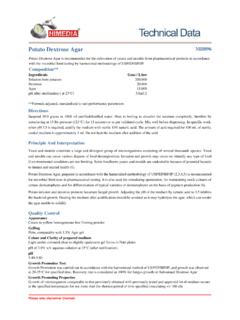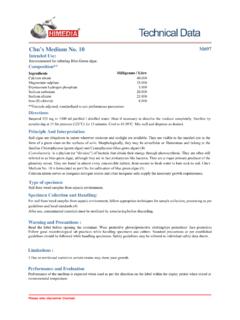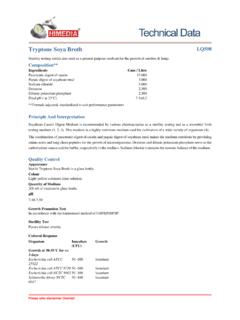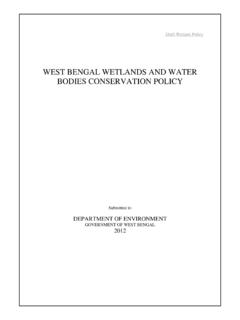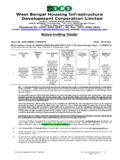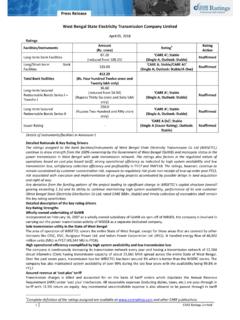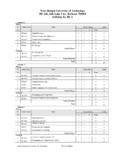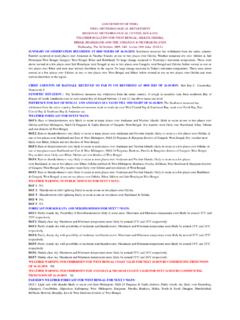Transcription of Rose Bengal Agar Base - HiMedia Leading …
1 Please refer disclaimer Bengal Agar BaseM842 rose Bengal Agar Base is recommended for the selective isolation and enumeration of yeasts and moulds fromenvironmental materials and **IngredientsGms / LitrePapaic digest of soyabean pH ( at 25 C) **Formula adjusted, standardized to suit performance parametersDirectionsSuspend grams in 1000 ml distilled water. Heat to boiling to dissolve the medium completely. Sterilize by autoclaving at 15 lbspressure (121 C) for 15 minutes. Cool to 40-45 C and add 2 ml of rehydrated Chloramphenicol Selective Supplement (FD033)for each 500 ml of medium. Mix thoroughly and pour into sterile Petri And InterpretationRose Bengal Agar is a selective medium to detect and enumerate yeasts and moulds in food samples. The use of media with anacidic pH that selectively inhibits the growth of bacteria and thereby promotes the growth of fungi has been widely employed(6, 1, 14). Neutral pH media with antibiotics is advantageous for fungal growth compared to acidified media as the later mayinhibit fungal growth or fail to inhibit bacterial growth (7, 9) and may restrict the size of mould colonies (13).
2 Smith andDawson (12) used rose Bengal in a neutral pH medium for the selective isolation of fungi from soil samples. Chloramphenicol,streptomycin, oxytetracycline and chlortetracycline have been used for the improved, selective isolation and enumeration ofyeasts and moulds from soil, sewage and foodstuffs (4, 5, 9, 11). rose Bengal Agar Base supplemented with chloramphenicol is a modification of the rose Bengal Chlortetracycline Agarformula of Jarvis (5). Instead of chlortetracycline, chloramphenicol is employed in this medium as a selective is recommended because of its heat stability and broad antibacterial spectrum (8). rose Bengal Agar isrecommended in standard methods for the enumeration of yeasts and moulds from foodstuffs and water (2, 3, 8).Papaic digest of soyabean meal provides the carbon and nitrogen sources required for good growth of a wide variety oforganisms. Dextrose is an energy source.
3 Monopotassium phosphate provides buffering capability. Magnesium sulphateprovides necessary trace elements. rose Bengal is a selective agent that inhibits bacterial growth and restricts the size and heightof colonies of the more rapidly growing moulds. rose Bengal is taken up by yeast and mould colonies, thereby facilitating theirrecognition and enumeration. Chloramphenicol Selective Supplement (FD033) inhibit 1 ml aliquots of a suitable series of dilution to Petri plates. Pour the cooled medium, mix well and incubate for upto 5days at 25 C. Calculate the number of yeasts or moulds per 1 gram or 1 ml by multiplying the number of colonies by dilutionfactor. Colonies of yeast appear pink due to uptake of rose to the selective properties of this medium and the type of specimen being cultured, some strains of fungi may grow poorlyor fail to grow on the complete medium; similarly, some strains of bacteria may also not inhibited or only partially should be taken not to expose this medium to light, since photodegradation of rose Bengal yields compounds that aretoxic to fungi (10, 2).
4 Quality ControlHiMedia LaboratoriesTechnical DataPlease refer disclaimer yellow to pink homogeneous free flowing powderGellingFirm, comparable with Agar gelColour and Clarity of prepared mediumDeep pink coloured clear to very slightly opalescent gel forms in Petri platesReactionReaction of w/v aqueous solution at 25 C. pH : ResponseM842: Cultural characteristics observed after an incubation at 20-25 C for 5 days with added Chloramphenicol SelectiveSupplement (FD033).OrganismInoculum(CFU)GrowthRecov ery*Aspergillus brasiliensisATCC 1640450-100goodCandida albicans ATCC1023150-100good>=50%Escherichia coli ATCC25922>=10 inhibited0%Micrococcus luteus ATCC10240>=10 inhibited0%Saccharomyces cerevisiaeATCC 976350-100good>=50%Storage and Shelf LifeStore below 30 C in tightly closed container and the prepared medium at 2 - 8 C. Use before expiry date on the Mossel D. A. A., Visser M. and Mengerink W. H. J., 1962, Lab Practice 11 Beuchat L. R. and Cousin M. A., 2001, In Downes F.
5 P. and Ito K., (Eds.), Compendium of Methods for the MicrobiologicalExamination of Foods, 4th Ed., American Public Health Association, Washington, Clesceri L. S., Greenberg A. E. and Eaton A. D., (Eds.), 1998, Standard Methods for the Examination of Water andWastewater, 20th Ed., American Public Health Association, Washington, Cooke W. B., 1954, Antibiot. and Chemother., 4 Jarvis B., 1973, J. Appl. Bacteriol., 36 Koburger J. A., 1976, In Speck M. L., (Ed.), Compendium of Methods for the Microbiological Examination of Foods,American Public Health Association, Washington, Koburger J. A., 1972, J. Milk Food Technol. 35 Marshall R. T., (Ed.), 1993, Standard Methods for the Examination of Dairy Products, 16th Ed., American Public HealthAssociation, Washington, Martin J. P., 1950, Soil Sci. 69 Banks J. G., Board R. G., and Paton J., 1985, Lett. Appl. Microbiol., 1 Overcast W. W. and Weakley D. J., 1969, J. Milk Technol.
6 , 32 Smith M. R. and Dawson V. T., 1944, Soil Sci. 58 Tyner L. E., 1944, Soil Sci. 57 Waksman S. A., 1922, J. Bacteriol., 7 : 1 / 2011*Key: Formerly known as Aspergillus niger HiMedia LaboratoriesTechnical DataHiMedia Laboratories Pvt. Ltd. A-516,Swastik Disha Business Park,Via Vadhani Ind. Est., LBS Marg, Mumbai-400086, India. Customer care No.: 022-61471919 Email: :User must ensure suitability of the product(s) in their application prior to use. Products conform solely to the information contained inthis and other related HiMedia publications. The information contained in this publication is based on our research and developmentwork and is to the best of our knowledge true and accurate. HiMedia Laboratories Pvt Ltd reserves the right to make changes tospecifications and information related to the products at any time. Products are not intended for human or animal or therapeutic use butfor laboratory,diagnostic, research or further manufacturing use only, unless otherwise specified.
7 Statements contained herein should notbe considered as a warranty of any kind, expressed or implied, and no liability is accepted for infringement of any patents.
